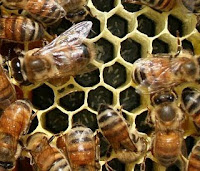Joe from Crystal came by the house a few weeks ago and indeed confirmed that I had no laying queen in the hive, and that there was no evidence of a virgin queen either. Though I still had plenty of bees in the hive, without a new queen, or any brood in the hive, they would slowly die off. So begins operation requeen. If there are young brood in a queenless hive, it is possible to introduce a queen in a cage (like when my first queen arrived), and let her emerge over a few days. The young gentle bees will take care of her, and she will start to lay. However, in the case of a queenless hive with no brood, like mine, introduction of a queen on her own is not likely the be successful. The old bees, who have been on their own for some time, will not take care of the queen, and may kill her. In this case, it is necessary to introduce brood and young bees at the same time as introducing a new queen. This is typically done with the addition of a nucleus, or as the beekeepers say, a nuc. A nucleus is typically 5 frames of bees, with young nurse bees, brood, and a queen.
 |
| Joe of Crystal Bee Supply setting up the paper merge |
Joe had been planning to bring over his nuc for several weeks, however the weather here has been quite hot for some time. When the weather is hot, the bees tend to hang out outside of the hive (called bearding), even over night, which makes it impossible for Joe to close up the hive and transport the bees to me. Last weekend I took my second hive body over to his shop with five empty frames, so that he could put the nuc frames into my furniture. After several reschedules due to hot weather, Joe finally was able to make it over to my house this morning to combine his nuc of Carnolian bees, to my old Italian bee hive. To ensure a friendly merge, a piece of newspaper was placed between the hive bodies--this way the bees have to eat through the paper before the hives are one. This gives a few days for the new queens pheromones to spread throughout the hive.
 |
| Drone brood--evidence of laying workers in my hive |
 |
| Shaking out my bees to eliminate laying workers |
Once the Carnolian bees were happily installed downstairs (we also put the hive on cinderblocks to lower the hive a bit--so that should we be so lucky enough to install honey supers later in the summer I won’t need a ladder), on went the newspaper and my hive body on top. As we started to look through my frames, it became clear that in the weeks since my original queen disappeared, some of my workers had started to lay eggs. Since these eggs are not fertilized, they can only develop into drone bees. Drone pupae are super big, and lead to bumpy capped brood. Joe was not thrilled about keeping the laying workers in the hive for the paper merge, as they apparently can cause trouble. So Joe proceeded to shake each and every single one of my frames of bees into my outer cover (there were at least 10,000 bees on those frames), and dumped the bees into a heap near the hive entrance. Joe says that all of the normal worker bees will be able to go back into the hive, but that the laying worker is so rotund and heavy from laying that she won’t be able make the journey. It is impossible for me to imagine this, but I am taking Joe’s word for it.
 |
| My bees headed back to meet the new Carnolian bees |
To help the bees back into the hive, Joe suggested we use a twig next to the hive entrance. He said that bees are lazy, and take the easiest route. Within minutes, there was a bee highway into the hive. Amazing. My concerns are that the laying worker might take the highway, or that my Italians might be mean to the new queen as they enter the lower brood box, but Joe assures me that this is the best option. I also received strict orders to continue to feed the bees sugar water until all 20 frames are drawn out with comb, so I set up a Boardman feeder with a mason jar. This is much easier to monitor and refill than the frame feeder I used at the beginning of the season. Next inspection will be in one week.



































